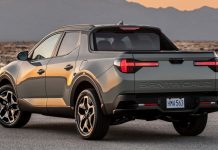Here’s the latest reader question, along with my reply!
Devon asks: Is four wheel drive the same thing as all-wheel drive? If not, what’s the difference?
My reply: There is a lot of confusion about this – which has been created, in my opinion, by the marketing people at the car companies. Allow me to elucidate.
In both cases – AWD and 4WD – all four wheels are “driven” (i.e., powered). At least, when the system is engaged. And here we come to the first of several differences.
Most AWD systems are full-time; that is, the system is always engaged – no action needed by the driver to engage the system, which automatically distributes power to both the front and the rear wheels.
Most 4WD systems are part-time; that is, the system is only engaged when the driver selects 4WD (usually, in modern vehicles, by turning a knob or pushing a button). If not engaged, only the rear wheels are powered.
No power is routed to the front wheels.
On the other hand, AWD systems usually – at least, typically – send almost all the power to the front wheels – until slip is detected, at which point the system automatically routes progressively more power to the rear wheels.
Some AWD systems can route almost all engine power to whichever pair of wheels (front or rear) have the most traction; most 4WD systems “lock” the power split in a 50-50 ratio, when the system is engaged.
4WD systems also have a two-speed transfer case, to increase mechanical leverage at low speeds.
Some AWD systems have a similar feature – but without a two-speed transfer case.
4WD systems are “heavier duty” – and designed mainly for dealing with off-road conditions and very deep snow.
AWD systems are lighter-duty, more on-road-minded and in addition to providing a traction advantage, also provide a handling advantage – on both wet and dry paved roads. Unlike 4WD systems – which can only route power front to back – most AWD systems can route power to individual wheels; also, there is no issue with axle bind – the inner wheel turning at a different rate than the outer wheel while cornering – because they can rotate at different rates.
In general, 4WD used to refer specifically to the systems you’d find in a truck or truck-based SUV – while AWD was found in cars and car-based crossover SUVs.
But “4WD” sounds more rugged and manly than “AWD” – and several car companies began (and still are) badging their AWD-equipped vehicles as “4WD.”
It is technically true, but arguably a bit shystery – because AWD is not the same as 4WD.
Ironically, AWD has advantages that 4WD does not – such as the handling advantage already discussed. Just as 4WD has its specific pros – as well as cons.
It’s too bad there’s less precision – and editorial honesty – in the way new cars are marketed nowadays.
. . .
Got a question about cars – or anything else? Click on the “ask Eric” link and send ’em in!
If you like what you’ve found here please consider supporting EPautos.
We depend on you to keep the wheels turning!
Our donate button is here.
If you prefer not to use PayPal, our mailing address is:
EPautos
721 Hummingbird Lane SE
Copper Hill, VA 24079
PS: Get an EPautos magnet (pictured below) in return for a $20 or more one-time donation or a $5 or more monthly recurring donation. (Please be sure to tell us you want a sticker – and also, provide an address, so we know where to mail the thing!)
My latest eBook is also available for your favorite price – free! Click here. 












You’re right, of course, but I’d like to add a little more.
It’s getting really hard to find the line between 4WD and AWD. It used to boil down to whether or not the vehicle has a transfer case, and that may still be the simplest definition. If the system is capable of tru 4Lo/4Hi selectability, then it’s 4WD. Even that is getting fuzzy these days.
Many traditionally 4WD trucks now also have electronics that use the ABS to shunt power around and to the tires that have traction, and many AWD vehicles have a simulated 4Lo range. Even within the same vehicle make and model, there may be more than one system available depending on options, some of which may be AWD and others 4WD. The Jeep Grand Cherokee has been like this in the past, and the current gen 4Runner has either AWD or 4WD depending on the specific trim level, if I remember correctly.
Then there are vehicles like the Land Cruiser that have real deal 4WD and transfer case with 4Lo but are called AWD because they are always powering all four wheels. Range Rovers often behave this way as well.
And, of course, many AWD vehicles only power all wheels when they detect slippage. Usually these behave like FWD vehicles until a second or two of slip is detected and the power is sent to the rear. The Honda CR-V behaves like this, as do most small crossovers.
A better test these days is to grade on performance. Setting up a roller test challenge, where one, two or three free rolling segments are placed under the desired wheels of a test vehicle, and the vehicle’s traction systems are pushed to their limits is very illustrative. Usually vehicles with 4WD and front and rear lockers can pull out of such traps, but so can Land Cruisers and Land Rovers using their superior electronics. Also, Subaru’s tend to do well in such tests. Many seemingly hard core off road rigs fall flat on their faces in such tests, as do nearly all crossovers, even the expensive luxury ones from Mercedes, BMW, etc that claim to be able to send power to only a single wheel with traction. This really separates the marketing from reality.
Yet in the real world, every little bit helps, and most AWD vehicles are more capable than we think. The real limiting factors are things like ground clearance, approach and departure angles, and break over angles. Most important is driver skill (and I don’t consider myself that skilled in this arena).
Most of the advantage of AWD/4wd is that you don’t have two dead wheels that the other two driven wheels are trying to push or pull.
In days of old 4WD almost always meant, in effect, 2 axle drive since most “4WD” vehicles didn’t have locking diff’s. A college buddy several years out of college complained mightily to me after going hunting in the mountains for Aoudad sheep. He said “Did you know my Blazer is NOT 4WD?”. I confirmed it was probably 2 axle drive if he didn’t order locking diff’s front and rear. It seems he had a front tire on a big hump, the diagonally opposed rear one on a big hump and the other tires just spun leaving him stuck.
I got a kick out of it since back then if you had a Blazer or Bronco you were superman in 4WDriving. Millions of people got disabused and educated at the same time to what 4WD “might” mean. I have quite literally gone around stuck “4WD” pickups in my El Camino that had great front to rear weight distribution and P’trac rear diff.
Since those days more pickups of 2 and 4WD come with limited diff’s with very few having a locking front. The old Full-Time Blazers had locking front and rears and you could tell it on pavement when turning sharply since you could feel the CV(constant velocity)joints loading up and then unloading as they turned.
The old Z 71 I drive has 2 WD, 4WD Hi and Lo plus a thing called “Automatic” which channels power around to where it’s needed as an AWD would do. It’s the nads for really slick stuff like ice and really slick mud.
My neighbors new F 250 Powerstroke 4WD has a great feature, an electrically locking rear diff. so in normal mode it reacted as an open diff which is better in going around corners and high speed curves alike. At the limit of cornering a lock rear diff can get you into trouble since once you lose traction and are turning it will continue to keep the vehicle turning, not a good thing when you desperately need to go straight. There are all sorts of limited slip diff’s and the friendliest are the clutch pack units. The “locker” style are pretty abused to the driveline to the point of full lock turning they slip over a dog and engage again in a very abusive way. Hard core guys like these. Ok, Young, hard core guys like these. Old hard core guys like the electrical lockers since they have experience of feeling their wallet getting lighter in the mehanical “locker” style rears. I have belonged to the latter category for 4 decades or so.
Big rigs with tandem axles use a power splitter front diff with the rear diff. doing all the driving till you flip the diff lock at which point both rears are pulling though neither one is “locking” since that wouldn’t last till the fire got hot in a dual axle truck. When you’re an owner/operator you aren’t keen on being in a situation where you need that feature very much. I want to voice a complaint about trucks in comparison from the old days to present. A locked diff always had a light on, generally red, right by the locking lever so you knew when it was engaged. You don’t see that anymore and in SHTF situations you might find yourself driving down the road after some serious pushing or pulling getting the rig unstuck, with the axles still locked together. If the highways is so slick you need them locked I solved this problem when I was in my early 20’s. I stayed at the house. It’s Texas after all and that day the whole country is iced over won’t be an advantage being on the road. It’s time to crank up some tunes, drink coffee(with a little bourbon)and know the next day or at least in two days it will all be over.
A couple years ago a company from Indiana called me and offered me a job. They asked how much experience I had with “chaining”. I replied I had never touched a “chain” and didn’t intend to do so. That ended the conversation.
My old Cherokee has the SelecTrac with the Fulltime 4wd (AWD) as well as 2hi, 4hi, and 4lo (+N of course). Per the original manual you can use the FT in all conditions including dry pavement which we do. It really gets you spoiled to just drive and not worry about shifting 2wd 4wd all the time. So far I really haven’t found a *road* condition that needed 4hi (center diff locked up). If I’m “off road” then I usually put it in 4lo to ease the strain on the transmission. But the jeep articulates pretty well even stock so you just don’t get that much diagonal spinning like you do on a truck/blazer/suburban etc. Downside is the rear squashes pretty quick if you start throwing in 50lb feed sacks. I’m thinking about an adjustable air shock/spring system just for shopping days ???
A funny sort of thing: we had to buy new tires about a month back because the ones that were on it when we bought it were so old they could not be repaired any longer. It snowed a couple days later and I was cussing the new tires because I couldn’t get up my driveway (both old and new ones were/are just highway tread). Then I discovered that the jeep was no longer in FT 4wd! Apparently the damn tire guy put it back in 2wd for some reason without saying anything. I put it back in FT 4wd and it goes like crazy now. The old black jeep was actually doing pretty dang good in 2wd on ~6″ of snow over icy hardpack, such that it took me a bit to realize that it wasn’t in 4wd.
BTW, old Colorado log truck drivers have LOTS of experience putting chains on // wink
My trucks 4wd but doesn’t have full time, so basically it’s rwd by default
Because of how 4hi/lo works, I only engage hi when it’s snowing and I won’t be going past 50, or if I’m Offroading and need more than locking the rear up
My Audi though is awd, just plan on upgrading the rear and center diff to make it more rw bias